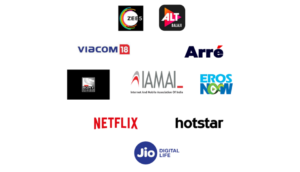Netflix, Hotstar, Reliance Jio, Zee5, AltBalaji, Sony-Liv,Viacom 18, Arre are some of the online video streaming platforms who have recently agreed to the Code on Self-Regulation drafted by the Internet and Mobile Association of India (IAMAI) [Read here]. However, Amazon Prime Prime, TVF, Hungama, Yupp TV Google and Facebook seem to be missing from the list of signatories to the Code. Amazon Prime Video has not signed the code, though it had contributed in its draft as the Company does not want to act in the absence of the government-mandated regulation.
The ‘Code for Best Practices for Online Curated Content Providers’ (Code) drafted by the Internet and Mobile Association of India (IAMAI) aims to act as guiding principles for Online Curated Content Providers (OCC Providers).
Key features of Part A of the Code:
The part starts with the Preamble which states that the Code has been jointly developed by OCC Providers who after signing the Code will commit to making reasonable efforts and acting in good faith to ensure that content offered on their respective services in India is in line with the principles laid out in the draft code. The code is applicable to all OCC Providers with the exception of those providers which make available any user generated content and intermediaries that provide access to repertoire of OCC Providers. The draft code also introduces as to what is OCC Industry and its key features. It also mentions the points which help in distinguishing the OCC Industry from that of Intermediaries and UGC Providers.
The Code also states that signatories to the Code preserve the freedom of speech and expression as envisaged in the Constitution of India as well as other statues like The Information Technology Act, 2000, Indian Penal Code, 1860. Further, the objectives of the code are enlisted as:
- Empower consumers to make informed choices on age-appropriate content;
- Protect the interests of consumers in choosing and accessing the content they want to watch, at their own time and convenience;
- Safeguard and respect creative freedom of content creators and artists;
- Nurture creativity, create an ecosystem fostering innovation and abide by an individual’s freedom of speech and expression; and
- Provide a mechanism for complaints redressal in relation to content made available by respective OCC Providers.
Key features of Part B of the Code:
The part deals with the Prohibited content which the signatories ensure that they will not deliberately and maliciously make available to the users. The code prohibits the following:
- Content which deliberately and maliciously disrespects the national emblem or national flag;
- Content which represents a child engaged in real or simulated sexual activities or any representation of the sexual parts of a child for primarily sexual purposes;
- Content which deliberately and maliciously intends to outrage religious sentiments of any class, section or community;
- Content which deliberately and maliciously promotes or encourages terrorism and other forms of violence against the State (of India) or its institutions; and
- Content that has been banned for exhibition or distribution by online video service under applicable laws or by any court with competent jurisdiction.
The Code could have explained these prohibitions in a better manner to avoid ambiguity. Given the number of content related litigations filed on obscenity, hurting religious sentiments, etc the generic language of the Code may result in fettering freedom of speech and expression.
Categorization: The Code also incorporates a clear and transparent disclosure system which will inform the viewer about the nature of content. This shall be done by categorising and classifying the content into separate and distinct categories such as General / Universal Viewing; Content which requires Parental Guidance and/or; Content which is solely meant for age-appropriate audiences (such age-appropriate audience may be further sub-categorised into different age groups). A guidance message will be shown particularly when the content is age-inappropriate for minors.
Grievance Redressal: The Code also addresses the mechanism for Complaints Redressal wherein each OCC Provider agrees to ‘internally’ appoint a person/team/department to receive and address any concern or complaints by the consumer in relation to the content of the respective providers. The department will act as a single point of contact for receiving all complaints and examining them. The contact details of the Department shall be made available by the signatory OCC Provider on its service application as well as their website.
- An aggrieved user may file a complaint with the Department of the relevant OCC Provider if such user finds any content available on relevant OCC Provider’s services to be in specific violation of the Code.
- The Department should acknowledge the complaint within three working days from the date of receipt of complaint. However, the department need not consider any anonymous or pseudo anonymous complaints.
- If the Department is of the view that the content in concern is consistent with the Code, then the Department shall appropriately reply to the aggrieved person within ten working days from the date of receipt of the complaint.
- In case, more time is required to ascertain if content in concern is consistent with the Code, then the Department shall appropriately reply to the aggrieved person indicating timelines which may not be later than thirty (30) days from the date of receipt of the complaint. In case of a violation of this Code, the Department must communicate to the aggrieved person within thirty (30) days of receipt of the complaint, specifying the precautionary action(s) taken to appropriately address the complaint.
- Also, Ministry of Information & Broadcasting, Ministry of Electronics & Information Technology, Government of India may forward any complaint to the Department of respective OCC providers.
Unlike the Self-Regulatory Guidelines of the IBF for television broadcasters, this Code fails to specify the consequences for non-compliance. There is no provision for any penalty/ punishment if the Grievance Redressal Department (GRD) does not respond within the prescribed period. Further, the Code does not specify for the minimum qualifications of the GRD members.
The key difference between the self-regulation of television broadcasting channels by BCCC (Broadcasting Content Complaints Council) and this IAMAI Code is that the constitution of BCCC comprises of 13 members including a judge, non-broadcast members, members from statutory commissions and broadcast members as well. This makes the BCCC an independent body giving its decisions more sanctity and giving more teeth to Self-Regulatory Guidelines of the IBF. Whereas the GRD as mentioned in the IAMAI Code is not a general body comprising of members from different OTT platforms but specific to each platform. It would have to be seen if the Government recognizes this IAMAI Code and if the presence of a GRD in each OCC Provider is recognized by courts as an alternative redressal forum before approaching the courts in content related litigations.
Image source: here



















![KARNATAKA HIGH COURT RULES THAT ONLINE CONTENT CANNOT BE REGULATED UNDER THE CINEMATOGRAPH ACT [READ JUDGEMENT]](https://iprmentlaw.com/wp-content/uploads/2019/09/sanskari-ott-100x70.jpeg)
Comments are closed.